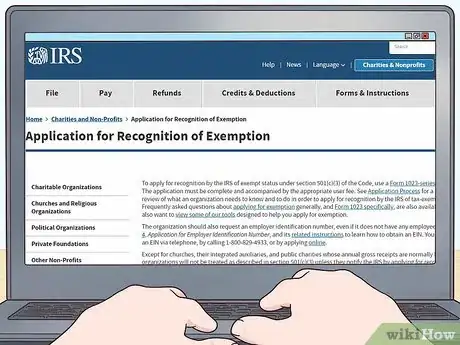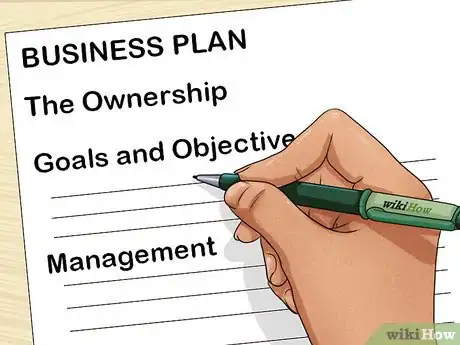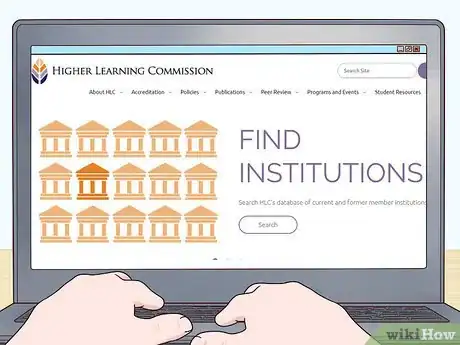This article was co-authored by wikiHow Staff. Our trained team of editors and researchers validate articles for accuracy and comprehensiveness. wikiHow's Content Management Team carefully monitors the work from our editorial staff to ensure that each article is backed by trusted research and meets our high quality standards.
There are 9 references cited in this article, which can be found at the bottom of the page.
wikiHow marks an article as reader-approved once it receives enough positive feedback. This article received 36 testimonials and 93% of readers who voted found it helpful, earning it our reader-approved status.
This article has been viewed 809,102 times.
Learn more...
Starting a private school is a long-term process that generally takes no less than 2 years. Private schools offer high-quality education and are not managed by the state. By starting a private school, you’ll be providing a valuable service to families with children in your community. Begin by tackling the big-picture planning questions that surround creating a school, and then move into hiring faculty and staff and recruiting students.
Steps
Choosing a School Structure
-
1Decide if the school will be for-profit or nonprofit. Make this decision before deciding on any other academic aspects of your school. Nonprofit schools will be managed by a board of directors. For-profit schools, on the other hand, will be overseen by a proprietor (potentially yourself) or by a business partnership or LLC. One structure is not better than the other. It’s simply up to you to decide how you want to manage and finance your school.[1]
- If you opt to run a non-profit private school, follow up by applying for 501(c)(3) nonprofit status with the IRS.
-
2Assemble a private school committee if your school is non-profit. This committee will work together to make crucial decisions about the school’s future, select a campus location, and hire faculty. The members will eventually become the core members of your board of directors. Committee members should be experts in different areas, including education, legal, accounting, business and construction.[2]
- If you aren’t sure who to ask to become a committee member, reach out to other private schools in your area. Talk to their administration members, and find out who those schools used as committee members.
Advertisement -
3Decide if you’d like to manage a day school or a boarding school. Day schools function like typical public schools and send students home at the end of a 6- or 7-hour day. Boarding schools house students overnight. Boarding-school students typically stay at the school for an entire semester. Boarding schools take more financial input and more work, but the students tend to become deeply involved in their communities and to form close professional bonds with their teachers.[3]
- As another option, consider a Montessori school. Montessori schools are almost always private and offer children a discovery-based model of academic experimentation and learning.
-
4Determine the grade levels for your private school. If you’re inexperienced or want to start small, open a private grade school that offers grades K-5. A small school will be easier to run, require a smaller campus, and have lower enrollment.[4] Or, if you’d like to start a larger school, opt to offer grades K-12.
- Many private schools start with fewer and lower grade levels and add upper grades over time. For instance, you could begin by offering K-5. Then, after 3 or 4 years, you can add grades 6-8.
-
5Find a building to house your private school. Plan to rent or lease a building in your community large enough—and in good enough repair—to house students.[5] Look around within residential or semi-residential areas within the community where you’d like to have your school. If no vacant school buildings currently exist, talk to city developer or commercial real-estate agents who may know of a viable school building.
- Unless you have a huge operating budget, do not plan to construct a new building for your school.
Creating a Business Plan and Finding Funding
-
1Write a business plan for your private school. Create a 5-year business plan, including operational plans (such as financial and marketing) and educational plans (such as educational focus, curriculum, implementation and assessment). The plan should also detail planned accomplishments such as expanding the campus or offering new grades.[6]
- Whether your school is nonprofit or for-profit, a business plan will help by setting the school on a successful path.
- A sound business plan will also inspire confidence—and generosity—in your potential financial donors.
-
2Determine the budget for the school. When setting up a budget, plan for a variety of expenses, including: leasing a facility, legal licenses and permits from the state educational board; hiring faculty members, staff, and a business consultant; and marketing and promoting the school.[7] Reach out to other private schools in the community and ask to review their budget. This will give you an idea of a private school’s annual costs.
- Your committee accountant or financial specialist should help with the budget. If you don’t have a financial specialist on your committee, seek expert financial advice.
- Starting a private school from scratch is an expensive undertaking. On average, starting a private school in the U.S. costs $1,000,000. The same undertaking in the U.K. costs, on average, £930,000.[8]
-
3Secure funding for your private school. If you are operating as a non-profit, solicit contributions by asking for donations from foundations, applying for grants and establishing donations from private donors. If you’re operating for-profit, student tuition will provide the majority of the income. Set a tuition rate that will cover the school’s expenses without being prohibitively steep.[9]
- When soliciting funds from financial partners, show potential investors your business plan. This will clarify to them that you know what you’re doing and that your private school is worth serious investment.
-
4Incorporate your for-profit private school as a business. Most private schools incorporate and apply for tax-exempt status. You’ll need to officially create the for-profit private school as a business and register the school with your state at least 1 year before opening its doors to students. File the appropriate paperwork with your Secretary of the State and the IRS.[10]
- If you have an attorney on your founding committee, ask them to handle this step. Their professional expertise will be invaluable.
Hiring and Training Key Staff and Faculty
-
1Interview and hire critical staff 18 months prior to the start of school. The first 2 staff members you should hire are the principal and a business manager. The administrator will be able to help you handle the educational and staffing aspects of the school plan, while the business manager will work with you on duties such as enrollment and purchasing.
- The principal and business administrator can work alongside your committee members to handle financial, legal, and academic obligations prior to the start of school.
-
2Hire administrative staff and open the business office. About 9 months before the start of school, begin holding interviews for the staff members who will work in the business office. Once the business office is open, the school can begin the admissions process for students. If you’re starting a small private grade school, you probably only need to hire 1-2 administrative staff.
- To find qualified applicants, post job descriptions on online job-finding sites like Monster, LinkedIn, and Indeed.
-
3Interview and hire at least 4 faculty members. Depending on the size of your school, you may wish to hire many more than 4 faculty members. However, for a small grade school, have a minimum of 4 faculty members for the first year. The 4 faculty members should specialize in core subjects including math, science, and language arts.[11]
- Once faculty members have been hired, ask them what supplies they’ll need in order to successfully teach their core subject. Work with them to order curriculum materials, furniture, and educational supplies.
-
4Train your faculty 4–5 months before the start of school. While your faculty should all be qualified to teach in their fields, they may not be familiar with the specific policies and academic outcomes that you want for your private school. So, provide faculty training sessions to familiarize the teachers and staff with the school, policies, procedures, expectations, curriculum, and your vision for the school.
- This will be especially valuable if you’re teaching in a private school where the majority of the curriculum has already been developed and is handed down to the instructors.
Registering and Opening the School
-
1Notify your state’s educational division that you’re starting a school. Do this at least 2-3 months before you plan to open the doors and offer classes. In some states, private schools are overseen by a division of the Department of Education. Other states have individual accrediting agencies for private schools. Follow your state’s procedures for registering an official private school with the state’s educational division.[12]
- The state will send a representative to the campus to inspect the facilities and make sure they’re up to code and safe.
- The state will also request a school calendar and list of the names of enrolled students.
-
2Apply for educational accreditation from recognized agencies. Accreditation shows that your private school program meets an established standard, determined by a rigorous approval process. Receiving accreditation from a regional agency will distinguish your private school as a quality program. Check your state’s legislation to find out if you’re legally required to accredit your private school.[13]
- If you're starting a school within the U.S., there are 6 regional educational accrediting agencies that you should apply to based on your location. These accreditation agencies include:[14]
- The Higher Learning Commission (HLC)
- The Middle States Commission on Higher Education (MSCHE)
- The Southern Association of Colleges and Schools Commission on Colleges (CACSCOC)
- The New England Commission of Higher Education (NECHE)
-
3Promote your private school to prospective parents and students. Marketing your school is an important part of drumming up interest within the community and boosting your enrollment numbers. Advertise for students through community, church and service groups. You can also advertise through local newspapers and magazines and submit your school to online and private school directories.[15]
- To help drum up interest online, ask one of your committee members to design a website that will provide admissions and enrollment information.
- Once you have some interested community members, you could offer a tour of the private school so that parents and potential students can become familiar with the building and layout.
-
4Open your private school and begin holding classes. Plan your opening for when other schools in the area are starting. This is usually in the early fall, around the second week of August in North America. Make the day special and fun for the enrolled students and their parents. For example, set up balloons and streamers, and alert the local press.[16]
- Have your committee/board members on hand as well. Also try inviting local government officials, like the city mayor or the district’s state representative.
Community Q&A
-
QuestionWhat are the formalities to get a business license?
 Community AnswerSpeak to your local city hall about acquiring a business license with limited liability (so that parents can't sue you for your own personal assets). After all, private schools ARE a business.
Community AnswerSpeak to your local city hall about acquiring a business license with limited liability (so that parents can't sue you for your own personal assets). After all, private schools ARE a business. -
QuestionCan I name my school the same name as another school?
 Community AnswerNo, even if it didn't infringe on any copyright laws it would still be confusing for your potential students and customers. It would be better to change it, even slightly to make your school stand out.
Community AnswerNo, even if it didn't infringe on any copyright laws it would still be confusing for your potential students and customers. It would be better to change it, even slightly to make your school stand out. -
QuestionDo I need a registration to start a private school?
 Community AnswerYou might, but it's better to consult with the state education board before you start, as different places have different requirements.
Community AnswerYou might, but it's better to consult with the state education board before you start, as different places have different requirements.
References
- ↑ https://cullinanelaw.com/how-to-start-a-private-school/
- ↑ https://www.privateschoolreview.com/blog/starting-a-private-school
- ↑ http://www.ourkids.net/school/day-vs-boarding-schools.php
- ↑ https://cullinanelaw.com/how-to-start-a-private-school/
- ↑ https://www.profitableventure.com/cost-start-a-private-school/
- ↑ https://www.privateschoolreview.com/blog/starting-a-private-school
- ↑ https://www.profitableventure.com/cost-start-a-private-school/
- ↑ https://www.profitableventure.com/cost-start-a-private-school/
- ↑ https://www.privateschoolreview.com/blog/starting-a-private-school
- ↑ http://www.fldoe.org/schools/school-choice/private-schools/opening-a-private-school.stml
- ↑ https://www.scholastic.com/teachers/articles/teaching-content/you-can-start-your-own-school/
- ↑ https://ncadmin.nc.gov/citizens/private-school/private-schools-k-12-requirements
- ↑ https://cullinanelaw.com/how-to-start-a-private-school/
- ↑ https://www.chea.org/regional-accrediting-organizations
- ↑ https://www.privateschoolreview.com/blog/starting-a-private-school
- ↑ https://www.privateschoolreview.com/blog/starting-a-private-school
About This Article
To start a private school, start with fundamental decisions like whether the school will be non-profit and what grade levels it will cater to. Next, write a detailed business plan and create a budget that includes how you plan to receive funding for the school. Then, hire critical staff members about 18 months before opening the school, bring on administrators about 9 months before opening, and spend 4-5 months training faculty. Finally, start promoting the school and enrolling students! For tips on registering the school with an accredited agencies, read on!
















































































